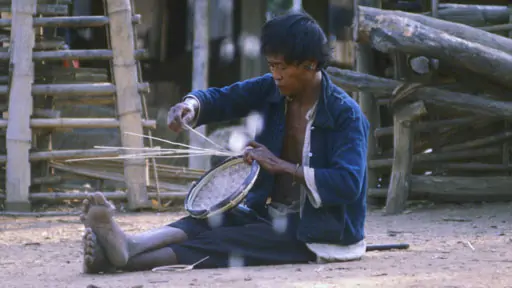Indigenous Calendar April, 2012: An Inspiration, Education and Hope

The final chapter of our first feature-length documentary, Peoples of the World: Southeast Asia, is entitled "Education and Hope." It relates how education can bring hope to the current generation of that region's indigenous people.
During the pre-production of this documentary we came to understand that, for the indigenous peoples of Southeast Asia, education and hope go hand-in-hand. We were reminded many times of how true this is during the actual production of the documentary. In the post-production process we soon realized that we needed an iconic image that would capture the theme of education and hope belonging together. We struggled to choose the most appropriate photograph to convey this theme.
Many people the world over hold the stereotypical belief that those who do manual work for a living must do so because they are uneducated. This belief is applied more to indigenous people than it is to non-indigenous people.
The An are one of Burma's many indigenous groups. They have very little contact with the outside world — mainstream Burmese society or the rest of the world. They speak their own language and they have their own traditions, customs and beliefs. Their livelihood comes entirely from manual work like farming and selling hand-woven cloth; but this is not because they are uneducated — instead it is precisely because they are educated.
Our documentary theme of "Education and Hope" begins by acknowledging that the indigenous peoples of Southeast Asia could not have survived for so long without education in how to do so. But basic survival skills are not the form of education that will bring hope to the An or to other indigenous peoples in the Twenty-first Century.
In the history of all human societies that abandoned a nomadic, hunting-and-gathering lifestyle, agriculture was the first development that allowed them to do so. Next came the kind of crafts that made their new lifestyle sustainable such as basket weaving. Literacy was always late in the development cycle yet it is a crucial enabler of many successful post-agrarian societies.
Many of the indigenous peoples of Southeast Asia are only now becoming literate; the An are not among them. This An man became the iconic image that we hope not only captures and conveys the theme of education and hope but also challenges the stereotype of uneducated people. He helped to inspire the closing words of our documentary: "With the barrier of literacy removed there can be no doubt that indigenous people are just as capable of academic achievement as anyone else."
If you enjoyed reading this article, please consider supporting independent, advertising-free journalism by buying us a coffee to help us cover the cost of hosting our web site. Please click on the link or scan the QR code. Thanks!


